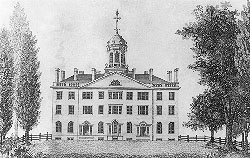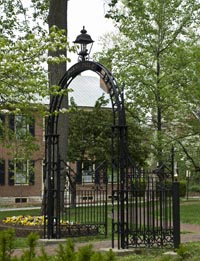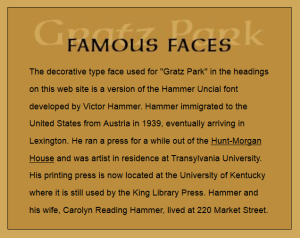History and Park Design

The Gratz Park Historic District occupies a tract of land that was established in 1781 as Outlot #6 when the town plat was prepared that year by order of the Virginia Assembly. In 1793 Transylvania Seminary purchased the lot as the site for its Lexington campus. In 1816 a large three-story structure, designed by Matthew Kennedy, Kentucky’s first architect, was built at the northern end of the lot to serve as the main building for Transylvania Seminary. Following the destruction of that building by fire in 1829, the Transylvania campus moved across Third Street to its present location. Only one building from this original campus remains, which is often referred to as “The Kitchen.” People began building private residences on the perimeter of this area in the 1790s.
Gratz Park is named for early Lexington businessman Benjamin Gratz. In 1824 Gratz bought the home on the corner of Mill and New Streets, and the home remained in the Gratz family until 1984. Gratz was a businessman, a trustee of Transylvania, a member of the city council, a founder of Lexington’s first public library, and a founder of the Lexington Ohio Railway.

During the Civil War, the lot was used as a parade ground and bivouac for Union and Confederate troops. In the decade after the Civil War the lot fell into neglect – full of tall weeds and a hangout for local ruffians. In 1875, Howard Gratz, the son of Benjamin Gratz and the publisher of The Kentucky Gazette, took it upon himself to improve the open green space by selling subscriptions to fund the improvements. Among other things, a wrought iron fence was placed around the entire perimeter with double gates at the four corners. In 1879, Mr. H. M. Sanford donated the arches placed at the four corners. The arch that is now in the park is an exact replica. The attached gates are original.
Howard Gratz’s improvements were finished by 1876. The park was dedicated on September 4, 1876 as Centennial Park, but the name was later changed to Benjamin Gratz Park. During the 25 years after the park was officially named, it was the center of community gatherings. Horse shows, band concerts, public meetings, and militia drills were among the activities. Howard Gratz continued to care for this property owned by Transylvania until the turn of the century. In the 1890s, he planted many of the park’s tulip poplars after a great storm had ravaged the older trees.
When Andrew Carnegie offered the city of Lexington $60,000 to build a library, the city fathers decided that Gratz Park was the best location. They negotiated with Transylvania and paid $9000 for the land to place the building in the southern portion of the park.
Anderson Gratz, son of Howard Gratz and grandson of Benjamin Gratz, opposed this location for the Carnegie Library. He had  become a very successful businessman in St. Louis, and he offered to purchase land anywhere else in the city as an alternative site for the library. His failure to save the southern portion of the park only further encouraged him to preserve the northern end of the park.
become a very successful businessman in St. Louis, and he offered to purchase land anywhere else in the city as an alternative site for the library. His failure to save the southern portion of the park only further encouraged him to preserve the northern end of the park.
In the first years of the twentieth century, the Transylvania Board of Trustees devised a plan to subdivide the park green space for homes. In 1915, Anderson Gratz offered to pay $21,000 to Transylvania for the northern portion of the park if the city of Lexington would also pay $10,000 to the college.
After a fairly lengthy period of negotiation and indecision, the city agreed in 1917 to follow this plan. Under the agreement, the city accepted Anderson Gratz’s generous donation with his restriction that the land of Gratz Park could never have buildings placed within the green space. The park thus remains largely as it has been for over a century.
In 1958 Gratz Park was named the first local historic district in Lexington, as well as of the Commonwealth of Kentucky. The park was listed on the National Register of Historic Places in 1979. Today the park is maintained by the Lexington Fayette Urban County Government Division of Parks and Recreation.
The Olmsted Plan

Frederick Law Olmsted (1822-1903) is recognized as the founder of American landscape architecture and the nation’s foremost park designer. Olmsted moved his home to suburban Boston in 1883 and established the world’s first full-scale professional office for the practice of landscape architecture. During the next century, his sons and successors perpetuated Olmsted’s design ideals, philosophy, and influence. The Olmsted firm’s plan for Gratz Park, which was created circa 1909, was never implemented. The plan included playgrounds, an arbor and gazebo style structure, and a large French styled parterre garden. The image to the right has been redrawn from the National Park Service – Frederick Law Olmsted Historic Site Plan # 3021-1.
Gratz Park Master Plan 2007
In 2006, the Gratz Park Neighborhood Association began the development of a Master Plan for Gratz Park. The primary goal of the plan was the creation of a document, which would promote preservation of the existing park landscape and outdoor spaces and provide written and graphic guidelines for improvements to selected areas.
The final plan indicates several overall improvements to the park. Whether you are viewing this plan in 2009 or many years later, improvements and upkeep of the park are the foremost concerns of the Gratz Park Neighborhood Association (www.gratzpark.org), which is the impetus for most park enhancements.
